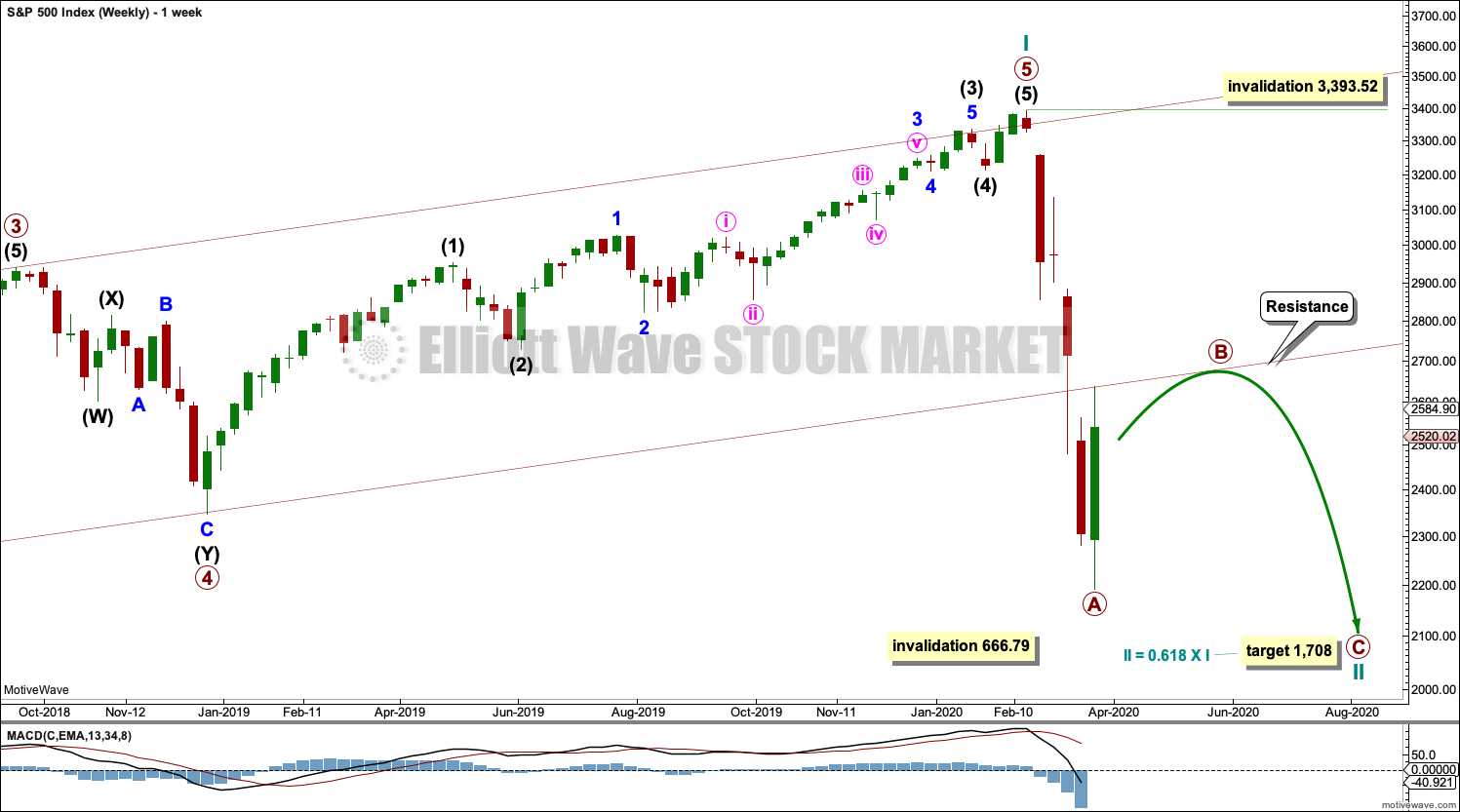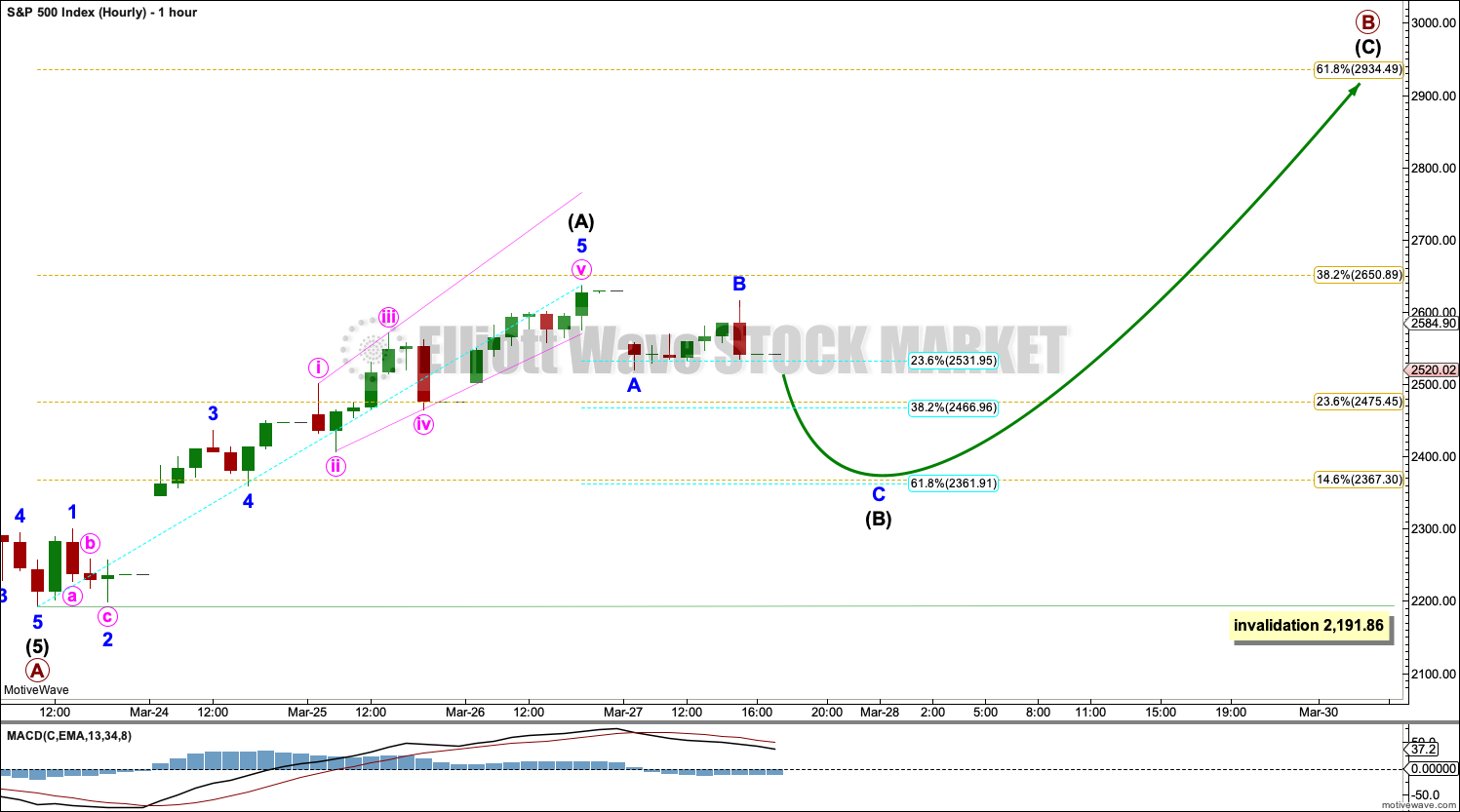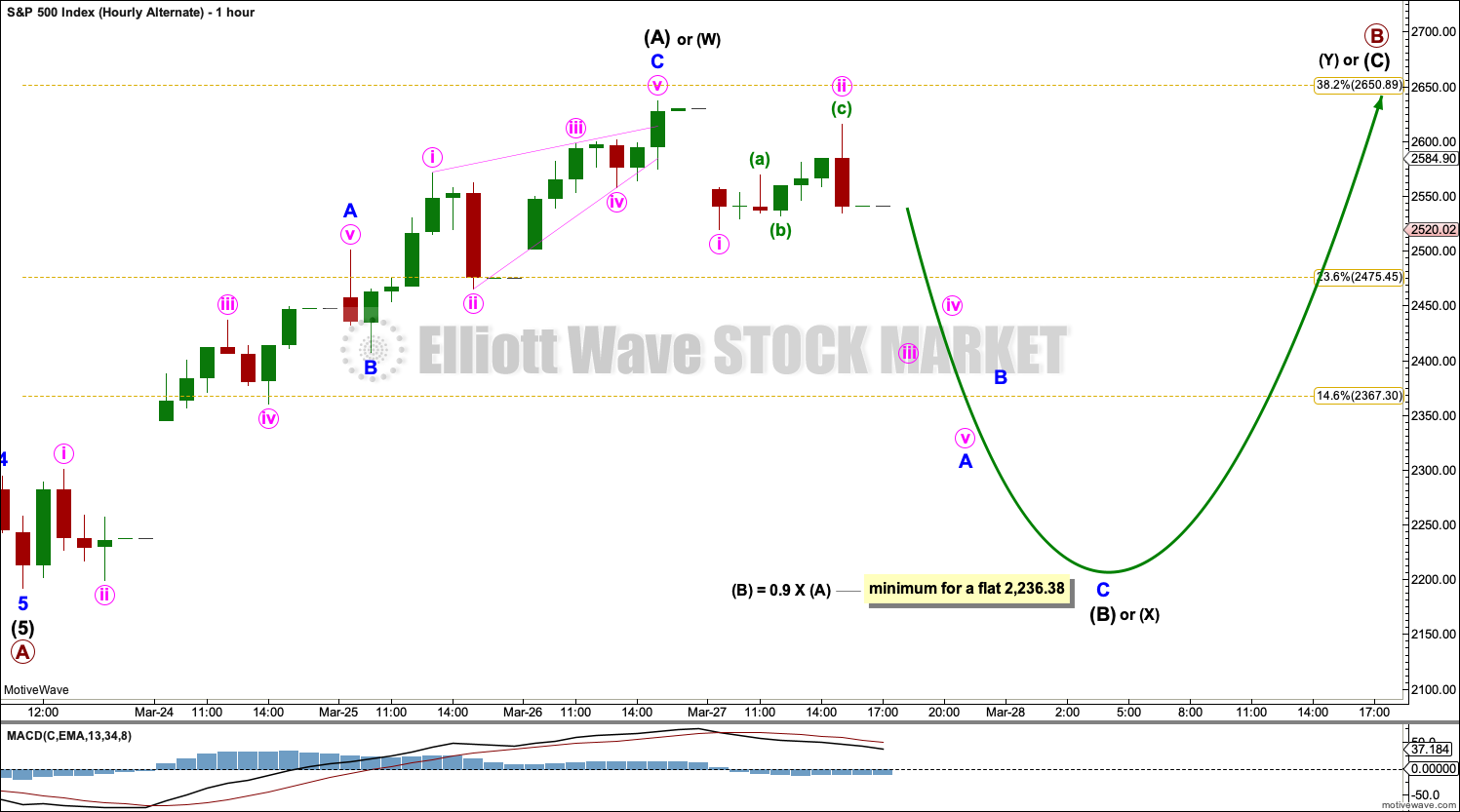S&P 500: Elliott Wave and Technical Analysis | Charts – March 27, 2020
Summary: Primary wave B may have begun. It may be either a quick sharp bounce or a long lasting sideways consolidation, which will be labelled primary wave B. Targets are 2,651 or 2,934.
Next week expect downwards or sideways movement as intermediate (B) within primary wave B unfolds. Thereafter, expect the bounce to continue to targets.
The biggest picture, Grand Super Cycle analysis, is here.
Last monthly charts are here. Video is here. Members are encouraged to view all three monthly charts. The third is much more bearish than this main wave count and remains a valid possibility.
ELLIOTT WAVE COUNTS
WEEKLY CHART
The channel is now breached by a full weekly candlestick below and not touching the lower edge. Further confidence in this wave count may be had. The lower edge of this channel is this week providing resistance. It may continue to do so.
Price is now below the 0.382 Fibonacci ratio of cycle wave I at 2,352. The structure of cycle wave II may need further to go to complete. The next Fibonacci ratio at 0.618 is now a preferred target for cycle wave II to end.
Cycle wave II would most likely subdivide as a zigzag; thus far that looks like what it is unfolding. When primary waves A and B may both be complete, then the target may be calculated using a Fibonacci ratio between primary waves A and C. At that stage, the final target may change or widen to a zone.
It is possible now that cycle wave II could be complete. This is outlined in a second alternate hourly chart below; in analysis of that chart I have outlined what needs to be seen for confidence in the alternate wave count.
Cycle wave II may not move beyond the start of cycle wave I below 666.79.
DAILY CHART
Redraw the wide maroon trend channel carefully: draw the first trend line from the end of primary wave 1 at 2,093.55 (December 26, 2014), to the end of primary wave 3 at 2,940.91 (September 21, 2018), then place a parallel copy on the end of primary wave 2 at 1,810.10 (February 11, 2016). The channel is fully breached indicating a trend change from the multi-year bull trend to a new bear trend. The lower edge may now be an important line of resistance.
Cycle wave II may subdivide as any Elliott wave corrective structure except a triangle. It would most likely be a zigzag. Primary wave A may be a complete five wave impulse. Primary wave B may not move beyond the start of primary wave A above 3,393.52.
HOURLY CHART
Primary wave B may subdivide as any one of more than 23 possible Elliott wave corrective structures. B waves exhibit the greatest variety in structure and price behaviour. Primary wave B may be a quick sharp bounce as in a single or multiple zigzag, or it may be a time consuming sideways consolidation as in a flat, combination or triangle.
This main hourly wave count considers the possibility that primary wave B may be subdividing as a zigzag. If primary wave B subdivides as a zigzag, then intermediate wave (A) must subdivide as a five wave motive structure, most likely an impulse.
It is possible that intermediate wave (A) could be over. Within intermediate wave (A), minor wave 5 is an ending expanding diagonal that meets all Elliott wave rules.
If intermediate wave (A) has subdivided as a five wave structure, then intermediate wave (B) may not move beyond its start below 2,191.86.
Intermediate wave (B) may subdivide as any Elliott wave corrective structure. It wold most likely subdivide as a zigzag as labelled. However, B waves within B waves are the most difficult piece of any correction to analyse. The labelling within intermediate wave (B) will likely change as it continues. Intermediate wave (B) may end about either the 0.382 Fibonacci ratio of intermediate wave (A) at 2,467, or the 0.618 Fibonacci ratio at 2,362. Neither may be favoured.
If primary wave A is correctly analysed as a five wave impulse, then primary wave B may not move beyond its start above 3,393.52.
ALTERNATE HOURLY CHART
It is also possible that primary wave B may subdivide as a flat, combination or triangle. This alternate wave count considers those possibilities in the one chart.
If primary wave B subdivides as any one of a flat, combination or triangle, then the first wave up within it should subdivide as a three, most likely a zigzag. Within the zigzag, minor wave A may be a complete impulse and minor wave C may be a complete ending contracting diagonal.
If primary wave B subdivides as a flat correction, then within it intermediate wave (A) may be complete. Intermediate wave (B) would need to retrace a minimum 0.9 length of intermediate wave (A). Intermediate wave (B) may make a new low below the start of intermediate wave (A) at 2,191.86 as in an expanded flat. There is no lower invalidation point.
If primary wave B subdivides as a triangle, then within it intermediate wave (A) may be a complete zigzag. Intermediate wave (B) may now unfold lower as a single or multiple zigzag; there is no minimum length required for intermediate wave (B) within a triangle. Intermediate wave (B) may make a new low below the start of intermediate wave (A) at 2,191.86 as in a running triangle. There is no lower invalidation point.
If primary wave B subdivides as a double combination, then the first structure in a combination may be complete, a zigzag labelled intermediate wave (W). The double may then be joined by a three in the opposite direction to be labelled intermediate wave (X), which would most likely subdivide as a zigzag. There is no minimum requirement for intermediate wave (X) and it may make a new low below the start of intermediate wave (W). There is no lower invalidation point.
TECHNICAL ANALYSIS
WEEKLY CHART

Click chart to enlarge. Chart courtesy of StockCharts.com.
A bounce has arrived within the bear market. It may continue further.
DAILY CHART
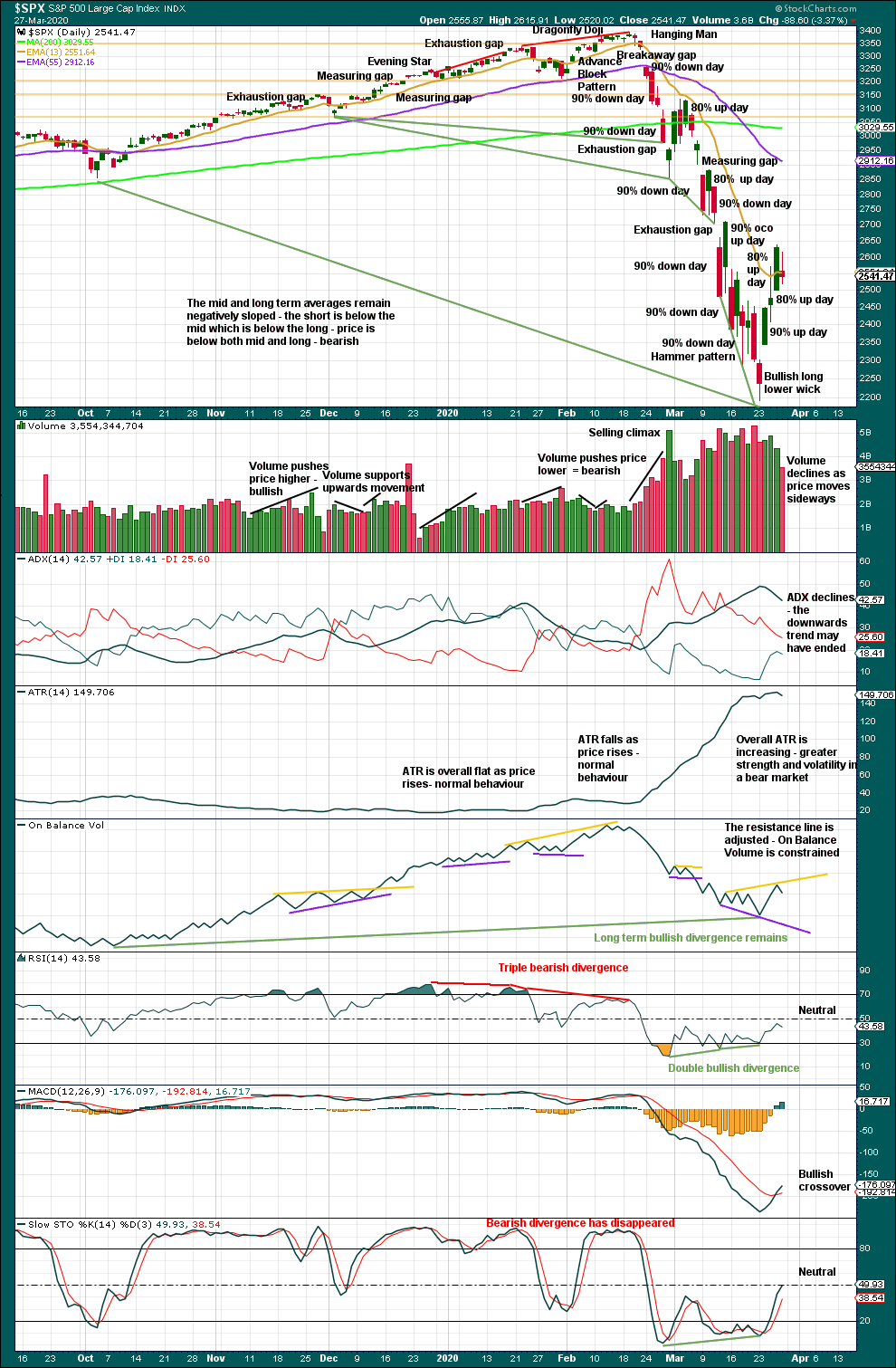
Click chart to enlarge. Chart courtesy of StockCharts.com.
There are now eight 90% downwards days in this strong downwards movement.
At the last low:
– RSI reached deeply oversold and now exhibits short-term double bullish divergence with price.
– Stochastics reached oversold and now exhibits short-term bullish divergence with price.
– On Balance Volume exhibited bullish divergence with price, although short-term bullish divergence disappeared.
Now a 90% upwards day and two back to back 80% upwards days give strong confidence that a low is in place. It may not be the end of the bear market though; the Elliott wave structure may not be complete.
A correction within the bear market looks to have arrived. It would be reasonable to expect choppy overlapping movement for at least a week or so, possibly over a month. To see what signals may be looked for to identify a high, the two previous large bear markets will be analysed below.
BREADTH – AD LINE
WEEKLY CHART
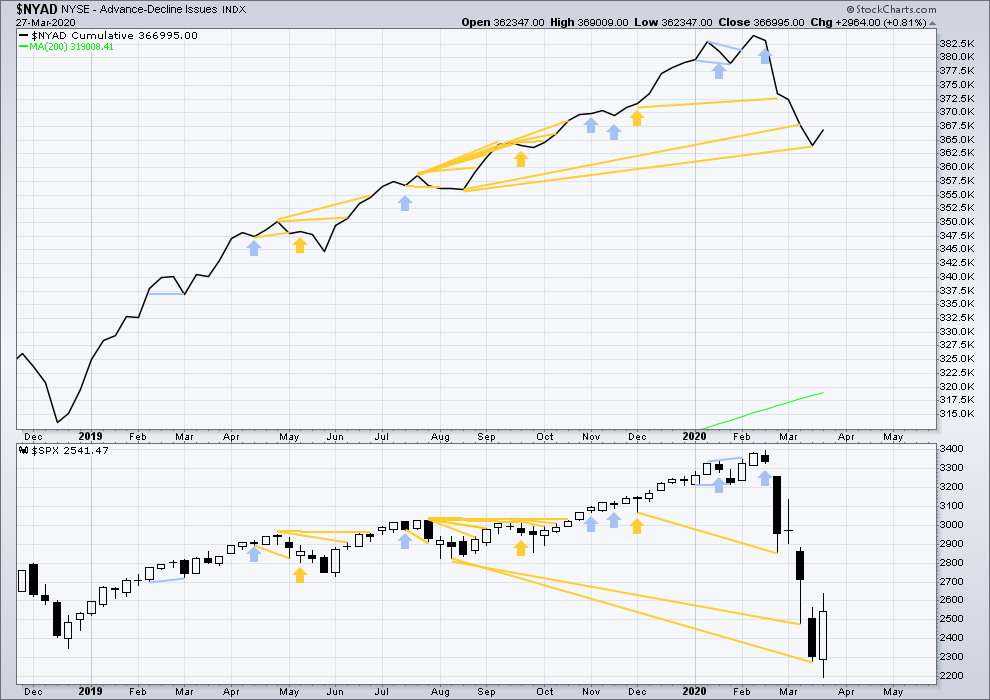
Click chart to enlarge. Chart courtesy of StockCharts.com. So that colour blind members are included, bearish signals
will be noted with blue and bullish signals with yellow.
Bear markets from the Great Depression and onwards have been preceded by an average minimum of 4 months divergence between price and the AD line with only two exceptions in 1946 and 1976. With no divergence between the AD line and price at the last all time high, this current bear market now makes a third exception.
In all bear markets in the last 90 years there is some positive correlation (0.6022) between the length of bearish divergence and the depth of the following bear market. No to little divergence is correlated with more shallow bear markets. Longer divergence is correlated with deeper bear markets.
This bear market comes after no bearish divergence. It would more likely be shallow, but this is a statement of probability and not certainty. So far it is slightly more than the 0.382 Fibonacci ratio of the bull market it is correcting (beginning March 2009).
This week an outside week closes green and the AD line supports upwards movement within the week. There is no new divergence.
Large caps all time high: 3,393.52 on 19th February 2020.
Mid caps all time high: 2,109.43 on 20th February 2020.
Small caps all time high: 1,100.58 on 27th August 2018.
DAILY CHART
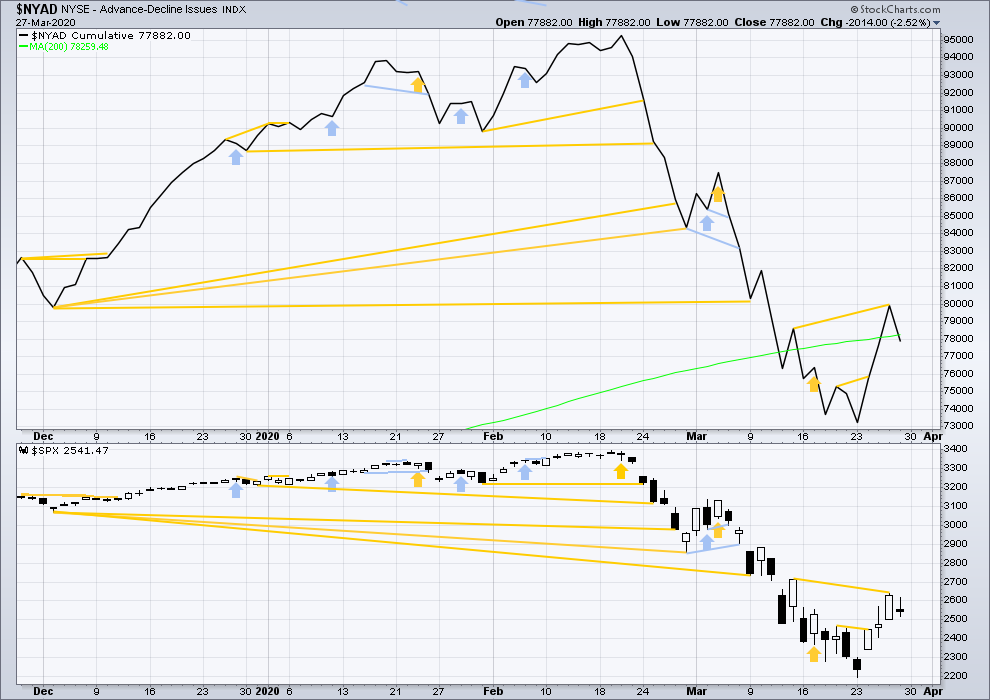
Click chart to enlarge. Chart courtesy of StockCharts.com. So that colour blind members are included, bearish signals
will be noted with blue and bullish signals with yellow.
Breadth should be read as a leading indicator.
To end the week both price and the AD line moved overall lower during Friday. There is no new short-term divergence.
VOLATILITY – INVERTED VIX CHART
WEEKLY CHART

Click chart to enlarge. Chart courtesy of StockCharts.com. So that colour blind members are included, bearish signals
will be noted with blue and bullish signals with yellow.
This week completes an outside week, which has closed green, and inverted VIX is overall flat. There is no new short-term divergence.
DAILY CHART
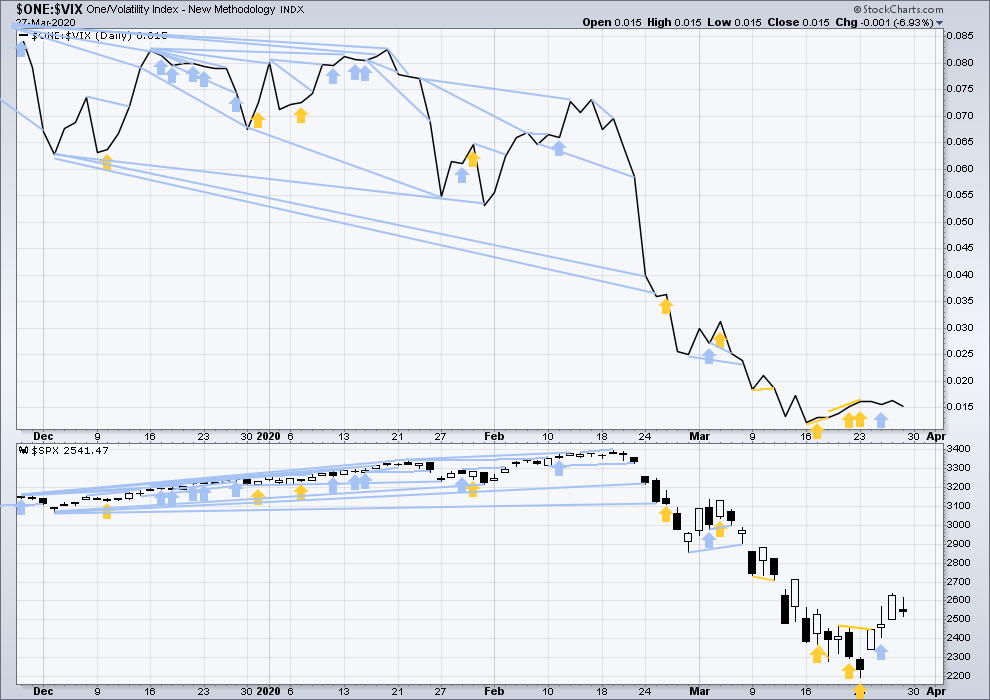
Click chart to enlarge. Chart courtesy of StockCharts.com. So that colour blind members are included, bearish signals
will be noted with blue and bullish signals with yellow.
On Friday price moved overall lower and inverted VIX has slightly declined. There is no new divergence.
DOW THEORY
Dow Theory has confirmed a bear market with the following lows made on a closing basis:
DJIA: 21,712.53 – a close below this point has been made on the March 12, 2020.
DJT: 8,636.79 – a close below this point has been made on March 9, 2020.
Adding in the S&P and Nasdaq for an extended Dow Theory, a bear market has now been confirmed:
S&P500: 2,346.58 – a close below this point has now been made on March 20, 2020.
Nasdaq: 7,292.22 – a close below this point was made on the March 12, 2020.
ANALYSIS OF CORRECTIONS WITHIN BEAR MARKETS
FIRST HISTORICAL EXAMPLE: DOTCOM CRASH: MARCH 2000 – OCTOBER 2002

Click chart to enlarge. Chart courtesy of StockCharts.com.
This first chart looks at the first half of the Dotcom crash. Several bounces are noted. Each is analysed below:
1. Ended September 1, 2000. The bounce lasted 97 days. An Evening Doji Star at the end; volume declined throughout but spiked on the final high; ADX indicated an upwards trend in the middle and again just at the end; ATR declined throughout; On Balance Volume did not confirm highs as it was flat while price was rising and then gave a bearish signal on the 12th of September; RSI exhibited weak bearish divergence at the high.
2. Ended November 5, 2000. The bounce lasted 13 days. A large Bearish Engulfing pattern two days after the high on the 8th of November; volume declined throughout; ADX declined throughout; ATR began flat and then declined at the end; On Balance Volume did not confirm the last two daily highs at the end and then gave a bearish signal a few days after the end on the 10th of November; RSI exhibited bearish divergence with the prior swing high labelled 1.
3. Ended January 31, 2001. The bounce lasted 26 days. A large Bearish Engulfing pattern two days after the high on the 2nd of February; volume declined throughout; ADX declined throughout; ATR declined throughout; On Balance Volume failed to confirm the last high and gave a bearish signal a few days after on the 7th of February; RSI exhibited no bearish divergence at the end.
4. Ended May 22, 2001. The bounce lasted 42 days. An Evening Star candlestick at the high; volume declined throughout; ADX exhibited a bullish trend in the middle and end; ATR declined throughout; On Balance Volume did confirm highs at the end; RSI exhibited no bearish divergence at the end.
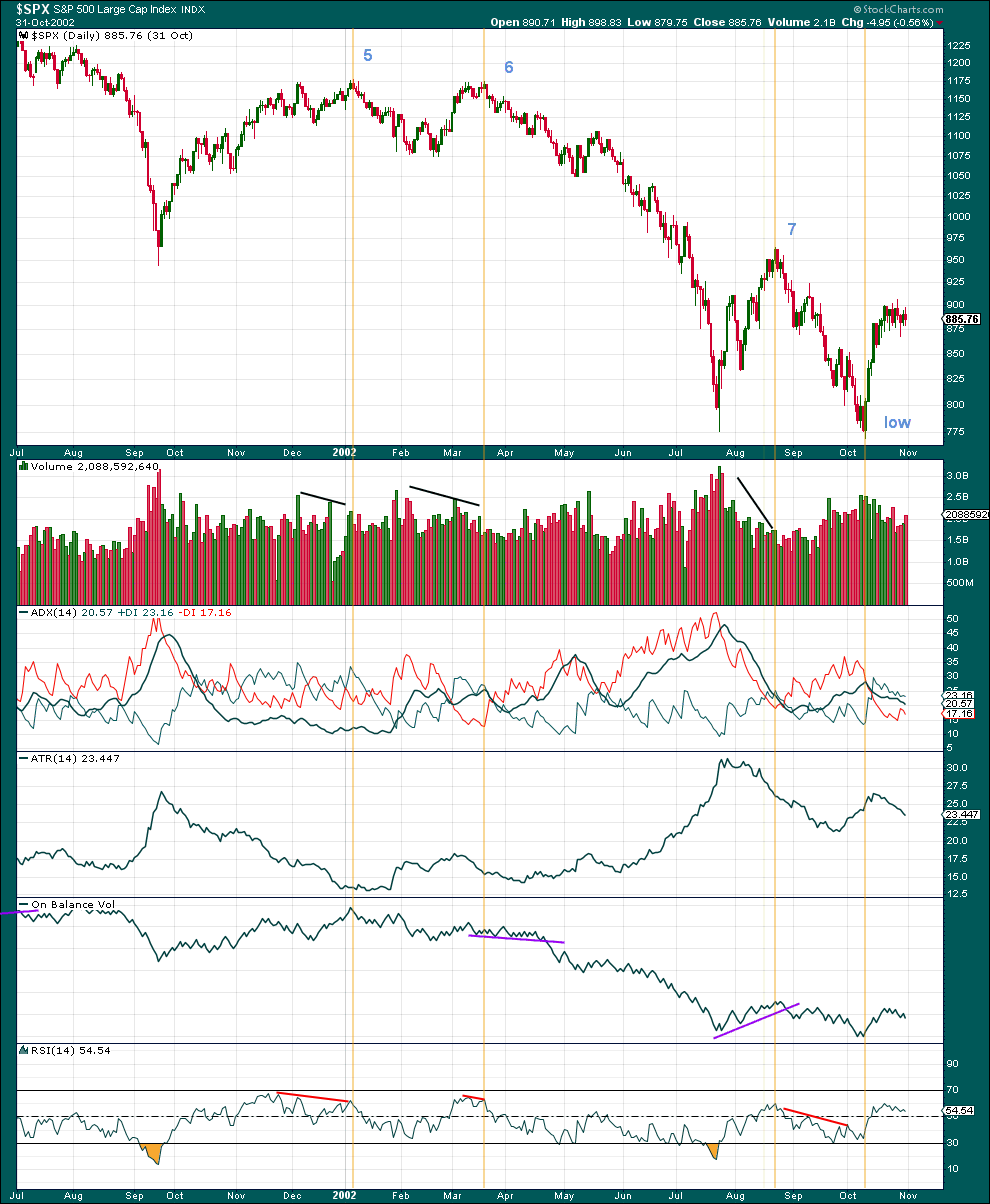
Click chart to enlarge. Chart courtesy of StockCharts.com.
This chart covers the second half of the Dotcom crash.
5. Ended January 7, 2002. (Note: my Elliott wave count labels this primary wave B within the crash). The bounce lasted 73 days. A Bearish Engulfing candlestick pattern at the high (there was one other prior within the bounce on the October 17, 2001); volume was not clear (overall, it declined throughout, but there was some increase at the end); ADX indicated an upwards trend early in the bounce but not at the end; ATR declined throughout; On Balance Volume did confirm highs at the end and gave no bearish signals; RSI exhibited single short-term bearish divergence at the end.
6. Ended March 19, 2002. The bounce lasted 17 days. A Bearish Engulfing candlestick pattern on the 20th of March; volume declined throughout; ADX indicated an upwards trend, which did not reach extreme; ATR declined only at the end; On Balance Volume did not confirm final highs; RSI exhibited single short-term bearish divergence at the end.
7. Ended August 22, 2002. The bounce lasted 21 days. Not correctly a Bearish Engulfing pattern at the end, but the candlestick of August 23rd did close well below the prior upwards session (noted that a strong Bearish Engulfing pattern occurred within the bounce on August 1st); volume strongly declined throughout; ADX strongly declined throughout; ATR declined throughout; On Balance Volume did confirm last highs and gave a bearish signal 6 days after on August 29th; RSI exhibited no bearish divergence.
Summary:
Major bounces may last at least two weeks or as much as 4 months. At the end of every bounce: There was a bearish candlestick pattern (although a few bounces also had bearish reversal patterns within them that may have given false signals of a more sustainable high in place); ATR declined throughout with one exception where it only declined at the end; in 4. and 7. On Balance Volume did not confirm new highs, but in 3. and 7. it did confirm new highs at the end; bearish signals from On Balance Volume came from a few to several days after in 4. and 7.; RSI exhibited bearish divergence in 4. and 7.
Conclusion:
The presence of a bearish candlestick pattern should be looked for.
Expect ATR to decline throughout as very likely.
Failure of On Balance Volume to confirm new highs may increase the probability of an end to the bounce, but be aware it may not do this. Any bearish signals from On Balance Volume may come a few days after a high.
If RSI exhibits short to mid-term bearish divergence at highs, the probability of a high increases.
Next end of week analysis will do the same process for the Global Financial Crisis (GFC) from October 2007 to March 2009.
Published @ 11:41 p.m. EST.
—
Careful risk management protects your trading account(s).
Follow my two Golden Rules:
1. Always trade with stops.
2. Risk only 1-5% of equity on any one trade.
—
New updates to this analysis are in bold.

